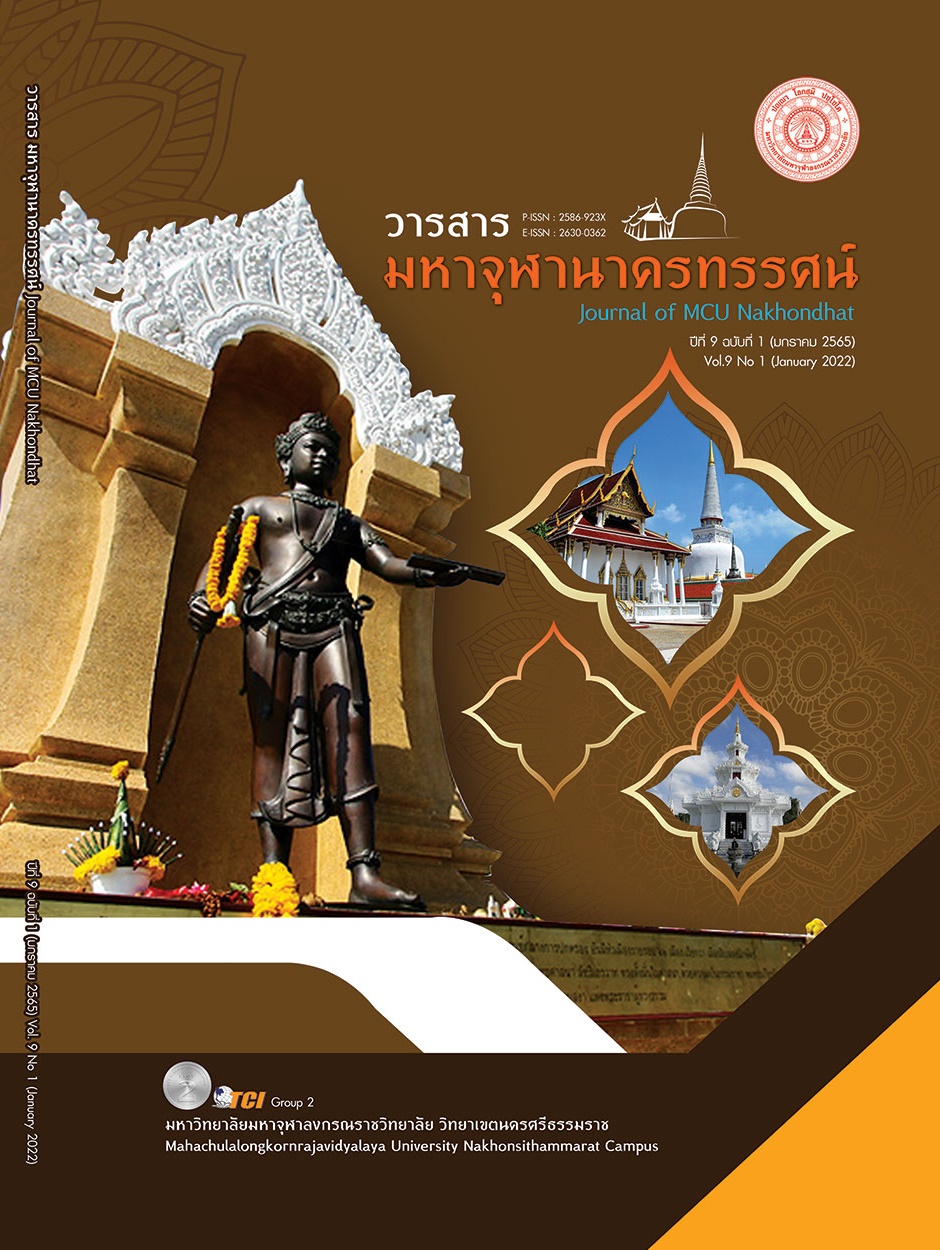NEW NORMAL BENEATH BUDDHISM
Main Article Content
Abstract
The way of life that has come across to be changed from one era to another era will inevitably change from the original. People’ beliefs or attitudes in the old era won’t be able to use in the modern era because the context of the modern society has change from the original. Good change must be maintained the goodness value and improved the past drawback so that it can develop into a good direction in accordance with the new way of life in the present society. Buddhism is an example of goodness that aims for teaching the Buddhists to live in the Dharma’s life principle for instance aside from bad things, do good things, and purify the mind. The Dharma’s principle in Buddhism is a universal theory that can be applied for solving the problems in various situations and many change events that may happen in every era. Because even the human body is being constantly transmuted. These are the facts that will happen to everyone, but not everyone will be able to understand and accept these changes. With the right guidance, they will be able to understand and accept the reality because everyone has the same aim in the way of life that is happiness. If there is suffering because of the problems in life. To make it as a normal life will be difficult. Thus, there must be the way for living as a normal life, even when facing with the problems or the unexpected changes, are possible. The principle of Buddhism, therefore, is a guide for living in the present era that the change can proceed normally and at last result in the happiness.
Article Details

This work is licensed under a Creative Commons Attribution-NonCommercial-NoDerivatives 4.0 International License.
References
กรมสุขภาพจิต. (2563). New Normal ชีวิตวิถีใหม่. เรียกใช้เมื่อ 17 พฤศจิกายน 2564 จาก https://www.dmh.go.th/news/view.asp?id=2288
กรุงเทพธุรกิจ. (2563). New Normal คืออะไร เมื่อโควิด-19 ผลักเราสู่ชีวิต 'ปกติวิถีใหม่'. เรียกใช้เมื่อ 17 พฤศจิกายน 2564 จาก https://www.bangkokbiznews. com/lifestyle/882508
นภาพัทธ์ งามบุษบงโสภินและมนตรี สิระโรจนานันท์. (2563). พุทธวิธีเพื่อการดูแลตนเองในสถานการณ์โควิด 19. วาราสารบัณฑิตศึกษาปริทรรศน์, 16(2), 42-56.
พระครูธรรมคุต (สุทธิพจน์) สุทฺธิวจโนและคณะ. (2564). การดำรงชีวิตวิถีใหม่ตามแนวพระพุทธศาสนา. วาราสารศึกษาศาสตร์ มมร., 9(1), 199-211.
พระพรหมคุณาภรณ์ (ป.อ ปยุตฺโต). (2546). พจนานุกรมพุทธศาสตร์ ฉบับประมวลธรรม. (พิมพ์ครั้งที่ 12). กรุงเทพมหานคร: กรมการศาสนา.
พระพรหมคุณาภรณ์ (ป.อ ปยุตฺโต). (2550). พจนานุกรมพุทธศาสตร์ ฉบับประมวลธรรม. (พิมพ์ครั้งที่ 15). กรุงเทพมหานคร: สำนักพิมพ์จันทร์เพ็ญ.
พระศากยวงศ์วิสุทธิ์ (อนิลมาน ธมฺมสากิโย). (2563). “ให้วัดอยู่ในบ้าน” โควิดทำวิถีพุทธเปลี่ยน แต่ไม่กระทบแก่นธรรม. เรียกใช้เมื่อ 17 พฤศจิกายน 2564 จาก https:// workpointtoday.com/vesak-day
มหาจุฬาลงกรณราชวิทยาลัย. (2539). พระไตรปิฎกภาษาไทย ฉบับมหาจุฬาลงกรณราชวิทยาลัย. กรุงเทพมหานคร: โรงพิมพ์มหาจุฬาลงกรณราชวิทยาลัย.
สยามรัฐออนไลน์. (2563). “วิถีชีวิตใหม่ New Normal“ โดยพระมหาโพธิวงศาจารย์. เรียกใช้เมื่อ 18 พฤศจิกายน 2564 จาก https://siamrath.co.th/n/166631
สอาด ภูนาสรณ์และคณะ. (2564). พุทธวิถีไทยสู่การพัฒนาที่ยั่งยืนในยุค NEW NORMAL. วารสารบัณฑิตศึกษามหาจุฬาขอนแก่น, 8(2), 14-26.
สุจิตรา อ่อนค้อม. (2547). การฝึกสมาธิ. (พิมพ์ครั้งที่ 8). กรุงเทพมหานคร: ดับเบิ้ลนายน.
MGR Online. (2551). สมาธิบำบัดโรค. เรียกใช้เมื่อ 3 ธันวาคม, 2564, จาก https:// mgronline.com/detail/9510000062999


